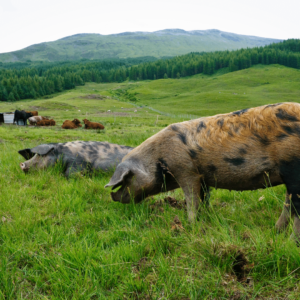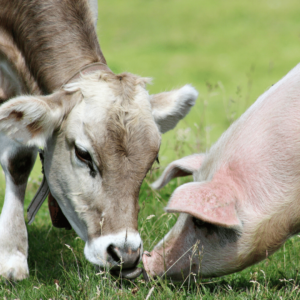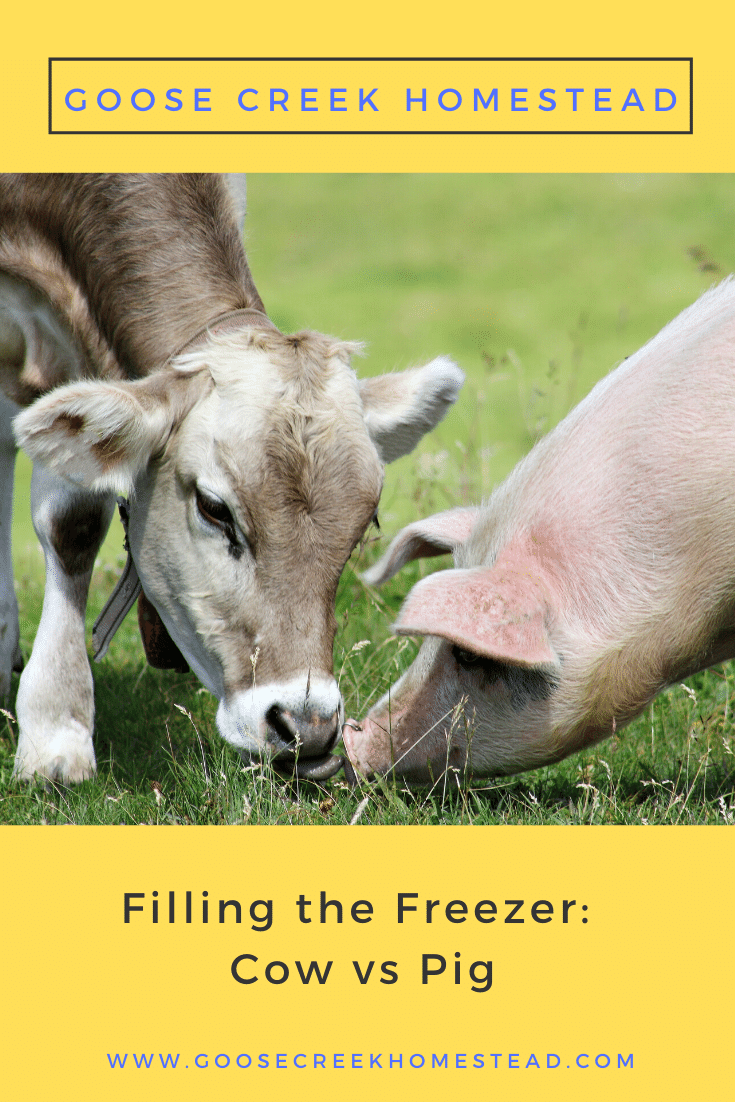Filling the freezer is a top priority on the homestead. But, which animal is the most economical to raise? Here we compare pigs vs cows to help you decide!
Filling the freezer is a top priority for most homesteaders, and when it comes to raising livestock for meat, pigs and cattle are two of the most popular. Yes, pigs have a bad reputation for being destructive and stinky, but with proper management, it doesn’t have to be that way. And, when they’re raised correctly, they can be incredibly economical on the small farm or homestead. Pigs are very affordable to purchase and raise, and just two piglets can fill up your freezer every year. Here’s why we think piglets are the most economical way to fill your homestead freezer.

Cow vs Pig: Space Requirements
Cattle require a lot of pasture space, especially if you don’t want to supplement their diet with a lot of hay and grain. But pigs can be raised in a much smaller area, so they can be a great option for the small homestead. Pigs only require about 20 square feet per adult, and less for weanlings or growers. Keep in mind that they will be less stinky if they have more space, so 50 square feet per pig is ideal. That’s still a lot less space than you would need for a cow.

Cow vs Pig: Pasture Quality
If you’re just starting out, there’s a good chance your homestead is mostly wooded. If you were to start out with cows, you would have to buy a lot of grain and hay to supplement their diet. On the other hand, pigs do great in wooded areas because they love the shade.
Pigs will even clean up fallen fruits and nuts in your orchard, so nothing goes to waste. Since they love to dig and root, they’ll help keep the space in between the trees clear of weeds and brush. They can also be useful for helping to clear wooded land to turn it into pasture (Check out our article on silvopasture coming out later this week!).
Cow vs Pig: Startup and Raising Costs
The cost of purchasing a weaned calf is generally around $600 – $800, depending on what part of the country you live in, and yearlings can be more than $1000. If you have the pasture, they could be finished on grass without much more investment until it’s time to put them in the freezer. That being said, most cattle farmers recommend finishing with grain for better flavor.
Meat steers are generally butchered at about 18 months old. That means, if you don’t have decent pasture you’ll be buying grain and hay for at least six months to a year or more to get them to finish weight.
On the other hand, weaner piglets can be purchased in most parts of the country for $50 – $75. They will need grain to get them to freezer-weight, but they are ready to butcher when they’re about six months old. That means you’ll only be feeding them for about four months, and they eat much less than a cow.
You can expect to buy around 650 pounds of commercial pig food to get your 50-pound feeder pig to a finished weight of 250 pounds. Depending on where you live, a 50-pound bag of 17% hog grower feed costs around $12. That means you’ll spend about $160 to feed each pig to get it ready for the freezer.
And, don’t forget that you can supplement your piglets’ diet with pasture and kitchen scraps to reduce feeding costs.

Filling Your Freezer Fast
As we already mentioned, steers aren’t butchered until they’re at least 18 months old. That means you have to wait a year and a half to fill the freezer. Pigs are ready to go in the freezer in six or seven months. If you buy eight-week-old weaner piglets and let them free feed, your freezer can be full of sausage, bacon, and pork chops in four months! If you raise two piglets every year, you’ll have enough pork to feed the average family all year long.

Steer vs. Piglet Yield
It’s true that you’re going to get 400 or 500 pounds of beef back when you butcher a steer, and that’s a lot of meat. It’s also a lot more meat than most people have the freezer space for. Not only that, but it’s only about a third of the cow’s live weight! Cows dress out at about 62% percent of their live weight, once the organs are removed. However, once the head, extra bones, extra fat, and skin are trimmed off, the usable beef is even less.
On the other hand, pigs dress out at an average of 74% of their live weight, which means your 280-pound hog could have a dressed-out weight of 207 pounds. They don’t have nearly as much bone as cows, so you don’t lose nearly as much weight with your finished cuts.
You can expect to get an average of 50% of the live weight back in usable pork. That’s 140 pounds of finished cuts from a hog you only had to feed for about four or five months and only paid about $75 for. Remember, a steer will cost you $800ish, and you’ve got to feed it for a lot longer to get back about 400 pounds of beef. When you break down the math, it’s really a no brainer.
Either way, you should always ask for the bones and fat from any animal you butcher. Fat can be rendered into lard to use for cooking and sautéing. It’s also great for seasoning your cast iron pans. The bones can be used to make bone broth and stock for cooking. You can also ask for the jowls and ham hocks of your hogs to grind up into sausage or you can smoke them and use them in soups.
Conclusion
When you have a pig on your homestead, there’s very little waste. Pigs will devour your kitchen scraps, leftovers, and garden waste. There really isn’t much they can’t or won’t eat. Some farmers feed their pigs entirely on food scraps, but they do better when given grain. Still, offering food scraps cuts down on your feed bill, making pigs much more efficient than cows.
If you’re looking for the most economical way to get meat in the freezer, pigs are a great choice. They don’t have nearly as many health issues as other livestock, so they’re perfect for beginning homesteaders. Just be sure to do your research and install quality fencing before you bring your piglets home because they are powerful and they’re excellent escape artists.





